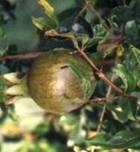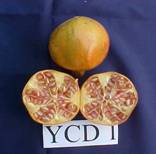Pomegranate (Punica granatum L.)
Punicaceae |
Varieties
Jyothi, Ganesh, Co 1, YCD 1, Araktha, Rudhra, Ruby and Mirudhula are the commercially cultivated pomegranate varieties.
 |

|
Co 1 |
YCD 1 |
Soil and climate
It is grown in a wide range of soils and it is drought resistant and tolerant to salinity and alkalinity. Cool winter and dry summer are necessary for the production of high quality fruits. It performs well up to 1800 m elevation.
Planting
Rooted cuttings or layers of 12 to 18 months age can be planted during June to December in pits of 60 cm x 60 cm x 60 cm at 2.5 to 3 m spacing either way.
Irrigation
Irrigation is done at 4 days interval.
|

Air layering |
Application of fertilizers: (per plant)
Manures and Fertilizers |
1st year |
2nd to 5th year |
6th year onwards |
| FYM |
10 kg |
20 kg |
30 kg |
| N |
200 g |
400 g |
600 g |
| P |
100 g |
250 g |
500 g |
| K |
400 g |
800 g |
1200 g |
Training and pruning
Fruits are born terminally on shoot growth emerging from mature wood. To promote new shoots on all sides annual pruning is done after harvest is completed during December by shortening of past season shoot by removing one third of the shoot. Besides, dried, diseased and cross-cross branches and root suckers are removed. The tree is trained to get a single stem upto 60 cm with 3 or 4 scaffold branches. Thinning of flower clusters ensures better size of the fruit. Spraying liquid paraffin at 1 % concentration at 15 days interval twice during June reduces fruit cracking.
Plant protection
Pests
Aphids
Release of first instar larvae of green lace wing bug Chrysopherla carnea @ 50 grubs/flowering branch four times at 10 days interval starting from flower initiation during April.
Fruit Borer
- Bag the fruits with polythene covers during flowering period to prevent egg-laying when the fruits are up to 5 cm diameter. Spray neem oil 3 % or NSKE 5% at the time of butterfly activity. Repeat it if necessary twice at an interval of 15 days.
- Adopt Economic Threshold Level (5 eggs/plant with bearing capacity of 60 fruits)
- Release T. chilonis @ 1 lakh/acre.
- Apply Chlorpyriphos 20EC 2 ml/lit; Malathion 50 EC 2 ml/lit
 |
| Holes on fruit |
Scales: Spray quinalphos 25 EC @ 2.5 ml per lit. of water
Yield
Depending up on the variety an average yield of 20-25 t/ha/year.
Market information
| Growing Districts |
Dindigul, Erode, Coimbatore, Tirunelveli |
| Major Markets in Tamil Nadu |
Coimbatore, Chennai |
| Preferred Varieties and Hybrids |
Bhagwa, Ruby (IIHR) |
| Grade Specification |
Size, Shape , Colour, Softness of seeds |
|




